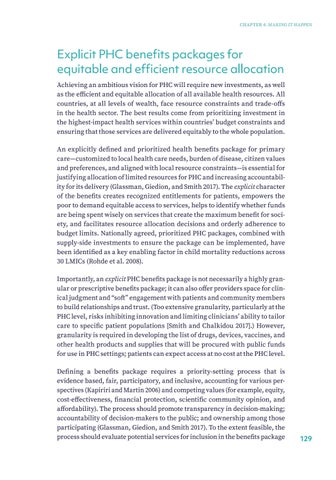CHAPTER 4: MAKING IT HAPPEN
Explicit PHC benefits packages for equitable and efficient resource allocation Achieving an ambitious vision for PHC will require new investments, as well as the efficient and equitable allocation of all available health resources. All countries, at all levels of wealth, face resource constraints and trade-offs in the health sector. The best results come from prioritizing investment in the highest-impact health services within countries’ budget constraints and ensuring that those services are delivered equitably to the whole population. An explicitly defined and prioritized health benefits package for primary care—customized to local health care needs, burden of disease, citizen values and preferences, and aligned with local resource constraints—is essential for justifying allocation of limited resources for PHC and increasing accountability for its delivery (Glassman, Giedion, and Smith 2017). The explicit character of the benefits creates recognized entitlements for patients, empowers the poor to demand equitable access to services, helps to identify whether funds are being spent wisely on services that create the maximum benefit for society, and facilitates resource allocation decisions and orderly adherence to budget limits. Nationally agreed, prioritized PHC packages, combined with supply-side investments to ensure the package can be implemented, have been identified as a key enabling factor in child mortality reductions across 30 LMICs (Rohde et al. 2008). Importantly, an explicit PHC benefits package is not necessarily a highly granular or prescriptive benefits package; it can also offer providers space for clinical judgment and “soft” engagement with patients and community members to build relationships and trust. (Too extensive granularity, particularly at the PHC level, risks inhibiting innovation and limiting clinicians’ ability to tailor care to specific patient populations [Smith and Chalkidou 2017].) However, granularity is required in developing the list of drugs, devices, vaccines, and other health products and supplies that will be procured with public funds for use in PHC settings; patients can expect access at no cost at the PHC level. Defining a benefits package requires a priority-setting process that is evidence based, fair, participatory, and inclusive, accounting for various perspectives (Kapiriri and Martin 2006) and competing values (for example, equity, cost-effectiveness, financial protection, scientific community opinion, and affordability). The process should promote transparency in decision-making; accountability of decision-makers to the public; and ownership among those participating (Glassman, Giedion, and Smith 2017). To the extent feasible, the process should evaluate potential services for inclusion in the benefits package
129


